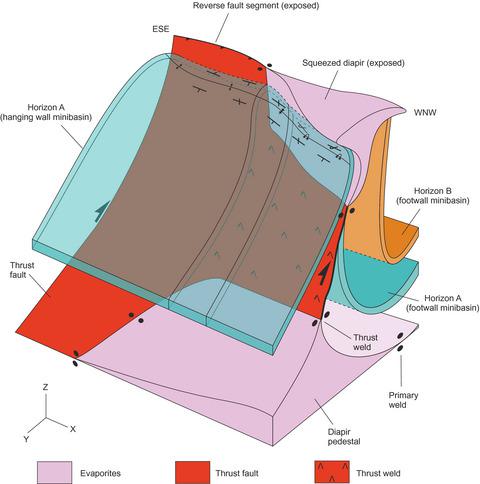当前位置:
X-MOL 学术
›
Basin Res.
›
论文详情
Our official English website, www.x-mol.net, welcomes your
feedback! (Note: you will need to create a separate account there.)
The transition from salt diapir to weld and thrust: Examples from the Northern Flinders Ranges in South Australia
Basin Research ( IF 2.8 ) Pub Date : 2021-06-03 , DOI: 10.1111/bre.12579 Oskar Vidal‐Royo 1 , Mark G. Rowan 2 , Oriol Ferrer 3 , Mark P. Fischer 4 , J. Carl Fiduk 5 , David P. Canova 4 , Thomas E. Hearon 6 , Katherine A. Giles 7
Basin Research ( IF 2.8 ) Pub Date : 2021-06-03 , DOI: 10.1111/bre.12579 Oskar Vidal‐Royo 1 , Mark G. Rowan 2 , Oriol Ferrer 3 , Mark P. Fischer 4 , J. Carl Fiduk 5 , David P. Canova 4 , Thomas E. Hearon 6 , Katherine A. Giles 7
Affiliation

|
The interactions between salt diapirs, thrust welds and thrusts in contractional belts are poorly understood due to, first, the inability of seismic data to distinguish between thrusts and welds or resolve associated sub-resolution deformation, and second, the paucity of good field examples. The Warraweena area in the Northern Flinders Ranges of South Australia contains examples of Neoproterozoic to Early Cambrian squeezed diapirs linked by steep reverse faults formed during the Delamerian Orogeny. Benefiting from good field exposures, we use geological mapping, cross-section construction and conceptual structural models to assess the three-dimensional geometry and evolution of the structures, the lateral transition from diapirs to linking faults and the variability of associated meso- and small-scale deformation. Three discrete diapirs consist of narrow outcrops of Callanna Group megabreccia (Willouran in age) up to 5-km long. Their diapiric origin is confirmed by local development of caprock, steepening of flanking strata in composite halokinetic sequences and reworked diapir and roof debris in adjacent strata. The surrounding rocks display only background levels of small-scale deformation. In contrast, the linking faults show no evidence of precursor diapirism, have fault-related anticlines up to 100s of m in wavelength in their hanging walls, and an associated increase in small-scale deformation (i.e. millimetre to metre scale folds, fractures and shear fabrics). The transitions from diapirs to faults occur within less than 200 m as short thrust welds at the diapir terminations. The exposed structures are analogous to those found on the subsurface of other salt basins such as the Gulf of Mexico and the South Atlantic conjugate margins. The results of this work can aid geoscientists evaluating three-way traps against squeezed diapirs, welds or faults, and can help them to predict the style and abundance of both halokinetic and small-scale structures that are below seismic resolution.
中文翻译:

从盐底辟到焊接和推力的转变:来自南澳大利亚北弗林德斯山脉的例子
对收缩带中盐底辟、逆冲焊缝和逆冲断层之间的相互作用知之甚少,首先是由于地震数据无法区分逆冲断层和焊缝或解决相关的亚分辨率变形,其次是缺乏良好的现场示例。南澳大利亚弗林德斯山脉北部的 Warraweena 地区包含新元古代到早寒武纪挤压底辟的例子,这些底辟由 Delamerian 造山运动期间形成的陡峭反向断层连接。受益于良好的野外暴露,我们使用地质绘图、横截面构造和概念结构模型来评估结构的三维几何形状和演化、从底辟到连接断层的横向过渡以及相关的中小断层的变异性。尺度变形。三个离散的底辟由长达 5 公里的 Callanna Group 巨型角砾岩(年龄为 Willouran)的狭窄露头组成。它们的底辟起源由盖层的局部发育、复合盐动力序列中侧翼地层的陡峭以及相邻地层中的底辟和顶板碎片的再加工证实。围岩仅显示小规模变形的背景水平。相比之下,连接断层没有显示出前体底辟的证据,在其上盘有长达 100 米波长的断层相关背斜,以及相关的小尺度变形增加(即毫米到米尺度的褶皱、断裂和剪切)织物)。从底辟到断层的过渡发生在不到 200 m 的范围内,作为底辟终端处的短推力焊缝。暴露的结构类似于在墨西哥湾和南大西洋共轭边缘等其他盐盆地的地下发现的结构。这项工作的结果可以帮助地球科学家评估针对挤压底辟、焊缝或断层的三向圈闭,并可以帮助他们预测低于地震分辨率的晕动结构和小尺度结构的类型和丰度。
更新日期:2021-06-03
中文翻译:

从盐底辟到焊接和推力的转变:来自南澳大利亚北弗林德斯山脉的例子
对收缩带中盐底辟、逆冲焊缝和逆冲断层之间的相互作用知之甚少,首先是由于地震数据无法区分逆冲断层和焊缝或解决相关的亚分辨率变形,其次是缺乏良好的现场示例。南澳大利亚弗林德斯山脉北部的 Warraweena 地区包含新元古代到早寒武纪挤压底辟的例子,这些底辟由 Delamerian 造山运动期间形成的陡峭反向断层连接。受益于良好的野外暴露,我们使用地质绘图、横截面构造和概念结构模型来评估结构的三维几何形状和演化、从底辟到连接断层的横向过渡以及相关的中小断层的变异性。尺度变形。三个离散的底辟由长达 5 公里的 Callanna Group 巨型角砾岩(年龄为 Willouran)的狭窄露头组成。它们的底辟起源由盖层的局部发育、复合盐动力序列中侧翼地层的陡峭以及相邻地层中的底辟和顶板碎片的再加工证实。围岩仅显示小规模变形的背景水平。相比之下,连接断层没有显示出前体底辟的证据,在其上盘有长达 100 米波长的断层相关背斜,以及相关的小尺度变形增加(即毫米到米尺度的褶皱、断裂和剪切)织物)。从底辟到断层的过渡发生在不到 200 m 的范围内,作为底辟终端处的短推力焊缝。暴露的结构类似于在墨西哥湾和南大西洋共轭边缘等其他盐盆地的地下发现的结构。这项工作的结果可以帮助地球科学家评估针对挤压底辟、焊缝或断层的三向圈闭,并可以帮助他们预测低于地震分辨率的晕动结构和小尺度结构的类型和丰度。











































 京公网安备 11010802027423号
京公网安备 11010802027423号